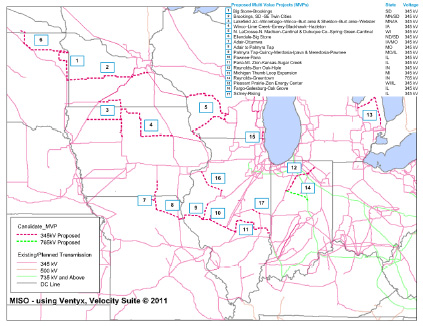State Journal reporter Judy Newman contributed to this report.
And MISO “approval” means exactly what?
December 9th, 2011
Here it is, MTEP 11, the Midwest Transmission Expansion Plan for 2011 (CLICK HERE, look on lower right), and it’s in the news too. The main report and some appendices:
MTEP 11 Appendix A-1_2_3 – Cost Allocation
Page listing all the Appendices
MTEP Appendix e52 Detailed Proposed MVP Portfolio Business Case
Please take note that this includes not only the CapX 2020 Brookings-Hampton line (#2 on map), but also the LaCrosse-Madison line (#5 on map), the one they need to build or they’ve got a lot of system instability goin’ on.
From my perspective, the most important thing to be aware of is that MTEP 11, and the MTEPs that preceded it, are about the shift to economic dispatch and development of the electric market. At the outset, MISO studied potential benefits of this shift, and found massive economic benefits, of which they speak in their press release. The economic benefits are realized by optimizing use of lower production cost generation, and in their own words, to “displace natural gas with coal.” Don’t believe it? Read this study that ICF did for MISO:
This is the worst possible result for those of us who breathe, and means that tens of thousands of landowners will have very high voltage transmission lines on their land, taken from them by eminent domain. These projects, almost all of the MTEP projects, are not about electric reliability, they’re “need” is to deliver market transactions of electric generation from any “point A” to any “point B,” and this is a private interest, a desire for market profits, and not a public interest.
Another issue looming is “what does MISO ‘approval’ mean?” Transmission lines are regulated by states, individually, and there is a movement to strip states of their regulatory authority and transfer that to federal entities. Look no further than Obama’s transmission “fast track” proposal, naming one of the CapX 2020 projects! States must make their energy regulatory decisions in an open, transparent process and based their decisions on ratepayer and public interest. That focus is not present in federal top-down edicts. States’ rights are at issue and we need to keep on our toes so this power shift doesn’t slide through.
And it’s not “just” the ICF report above, that’s it’s all about coal is clear from prior press. Here’s an important sentence, quoting GRE’s spin-guy Randy Fordice — explaining what we all know, that the MISO effort to get the “benefits” of displacing natural gas with coal:
Coal with benefits, yesiree… Gotta hand it to Fordice for being honest!
What does Obama’s Xmsn push mean?
October 10th, 2011
Aside from unprecedented corporate toadyism? Bowing to corporate greed at public expense? Methinks it means that the feds are stomping on states’ rights, and the states will fiercely fight to preserve their authority. Despite assurances by DOE’s Lauren Azar that they won’t be doing anything they already can’t do, I’m beyond skeptical.
The feds will have one big fight on their hands, a la the fight about states’ rights, whether for consultation on NEITC transmission or their right to deny transmission permits under the NIETC regs:
NIETC designation of corridors tossed out by 9th Circuit Court!!
Denial is NOT withholding… Piedmont v. FERC
Obama’s transmission push is ostensibly based on a Memorandum of Understanding that was signed by federal agencies, note that it is about “federal lands.”
CLICK HERE for the page that claims they’ll “expanding the scope of activity beyond federal lands.” How long before they change that sentence?!?!
For lots of info about this from a more easterly perspective check here:
Here’s what it could mean in practice – a $60 million pay-out to allow the line to go through:
Obama Administration Draws Criticism For Fast-Tracking Transmission Line Project Through National Park Units
Submitted by Kurt Repanshek on October 10, 2011 – 1:41am
A decision by the Obama Administration to fast-track seven power transmission line projects, including one through several units of the National Park System, has drawn condemnation from conservation groups.
Interior Secretary Ken Salazar says the fast-tracking shows the administration’s commitment to developing “the kind of critical infrastructure we should be working together to advance in order to create jobs and move our nation toward energy independence.”
But the secretary seems tone-deaf to groups that oppose the transmission project that would run across the Appalachian National Scenic Trail and through the Delaware Water Gap National Recreation Area and the Middle Delaware National Scenic River.
“The Obama Administration has failed to protect three popular national park sites in New Jersey and Pennsylvania with today’s decision to include the controversial Susquehanna-Roseland power line project on its list of fast-tracked transmission projects,” said Bryan Faehner, the National Parks Conservation Association’s associate director for park uses.
“Susquehanna-Roseland proposes to build massive 200-foot towers and power lines across the Delaware Water Gap National Recreation Area, the Middle Delaware National Scenic River, and the Appalachian National Scenic Trail in New Jersey and Pennsylvania. Delaware Water Gap alone enjoys more than five million visitors annually – most of which come from nearby urban areas – seeking the park’s inspiring views and outstanding recreational opportunities,” he added.
“Building massive power lines across these parks will harm the very resources they were designated to protect. This development can only harm visitors’ experience to the parks and puts economic benefits to local communities at risk. Unlike other proposals mentioned on the administration’s list, the Susquehanna-Roseland power line proposal would not help bring renewable energy sources on-line. Instead, it would transmit electricity produced by dirty coal-fired power plants.”
Last month Delaware Water Gap officials announced that a new alternative developed by the applicants has been added to their environmental analysis of the project, alternative 2b. Alternative 2b would be built within the existing right-of-way of the applicants’ original proposal, alternative 2.
“Under alternative 2b, the applicants would not request any additional ROW. They have stated they can safely operate the new line within the existing ROW, which has some sections 100 feet in width,” the NRA officials said at the time. “Construction would still require additional clearing for access roads and other features.”
The administration’s announcement last week to fast-track the project also was criticized by Public Employees for Environmental Responsibility, which said the decision “is a move to bypass proper environmental review designed to protect one of the most scenic areas of the entire national park system.”
“We do not object to fast-tracking projects as long as political appointees follow the laws protecting parks and the environment–but that hasn’t happened here,” said PEER Executive Director Jeff Ruch in a press statement. “Using jobs as a pretext is misplaced. More jobs can be created by protecting parks than by trashing them.”
PEER contends that Secretary Salazar, National Park Service Director Jon Jarvis, and other Interior officials have met repeatedly with project proponents, PPL Electric Utilities of Allentown, Pennsylvania and Public Service Electric and Gas Company of Newark, New Jersey, and have already approved a route for a new power line that will cut across the Delaware Water Gap NRA and the Appalachian Trail.
As part of the deal, PEER said the draft EIS will not consider at least two alternatives that would lessen impacts to the park’s scenery but will include at least one alternative (2B) demanded by the companies that is untenable from a safety perspective. The secretary and the director have unofficially committed to the companies that the NPS will select Alternative 2, the alternative preferred by the companies but which is the most damaging to the resources and scenery of the parks, PEER argued. In return, the companies have reportedly agreed to pay $60 million for land acquisition and administration inside and near the NRA.
“This is not ‘fast track,’ it is a short circuit in which political appointees are putting their thumbs on the scale to skew the review process,” Mr. Ruch added. “It is one thing to select an alternative after the conclusion of the NEPA process, but is something else to decide on the alternative before public comment has even begun.”
© Copyright 2011 National Park Advocates, LLC.
Obama’s Transmission BS in the News
October 5th, 2011
What does Obama’s transmission “streamlining” “fast track” agenda mean for states’ authority over need for and routing of transmission?
What does Obama’s transmission “streamlining” “fast track” agenda mean for federal agencies charges with NEPA environmental review of these transmission projects?
What does Obama’s transmission “streamlining” “fast track” agenda mean for public participation and due process?
Does Obama have a clue how many landowners/voters are affected by CapX 2020?
$$$$$$$$$$$$$
These are TWO of my transmission projects he’s targeting, TWO, the CapX 2020 Hampton-LaCrosse transmission line and the Susquehanna-Roseland transmission line. Here’s the Dept. of Interior Press Release:
Obama Administration Anounces Job-Creation Grid Modernization Pilot Projects
Susquehanna-Roseland in the news:
Obama backs power line upgrade that passes through Morris County
I guess we know why he was in Cannon Falls… at least part of it… I hate to think what else might have been on the agenda.
Here’s what’s flying out in the press about Obama’s Transmission Toadyism and CapX 2020, many are pretty much just a cut and paste of the White House press release:
Rochester Post Bulletin: Obama Administration to fast track CapX 2020, other power-line projects
Minnesota Public Radio: Obama seeks fast track for powerlines in Minn., elsewhere
Here’s one with some substance:
Feds step up power line projects in 12 states, including one in Wisconsin
Once more with feeling:
What does Obama’s transmission “streamlining” “fast track” agenda mean for states’ authority over need for and routing of transmission?
What does Obama’s transmission “streamlining” “fast track” agenda mean for federal agencies charges with NEPA environmental review of these transmission projects?
$$$$$$$$$$$$$


